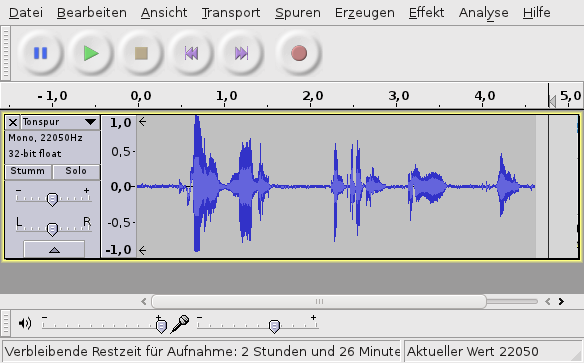Marble/VoiceOfMarble/Recording
Appearance
< Marble | VoiceOfMarble
Audacity is an open source audio recorder. It's a good choice to do your voice recordings for Marble. Of course it's also possible to use different software if you want to.
Initial Setup
- Ask your system administrator to install audacity on your system if it's not installed yet. Audacity is available in any sane Linux distribution. Versions for Mac and Windows exist as well.
- Connect your microphone to your system
- Start audacity
Voice Sample Recording
- Get another voice sample to speak from the translations page
- Press the record button in audacity
- Speak the text
- Press the stop button
- Play the spoken text. If it's not ok, record it again
- Cut any excessive silence at the start and the end
- Normalize the voice sample (effects menu)
- Export the voice sample (File, Export) as ogg vorbis. See the translations page for the filename
Alternative Voice Sample Recording method
- Get the list of the voice samples to speak from the translations page
- Press the record button in audacity
- Speak a line of text
- Pause for 2 seconds
- Speak another line of text, etc
- When you're done, hit the stop button
- Play the whole file, stop when you think you must record again
- Select the part of the recording to record again
- Hit Generate > Silence to remove the recording
- Press the record button to record again in another track
- When you're done, export this as a single ogg file to merge all the tracks
- Open this file and run Sound finder in Analyse
- Change the values until you get 64 labels matching the recordings
- Run Multiple export, select ogg vorbis, the folder to export to (that we call [AUDACITY_FILES_DIR]) and hit Export
- Download the File:Marble-voice-files-name.sh.tar.gz script, extract and chmod a+x marble-voice-files-name.sh
- ./marble-voice-files-name.sh [AUDACITY_FILES_DIR] [MARBLE_FILES_DIR]
- Your files are ready with the proper names in [MARBLE_FILES_DIR]
Tips
- Make sure no other sound disturbs your recordings.
- Repeat several recordings to find the optimal volume setting of the microphone
- Sometimes it's easier to speak longer sentences or to repeat the same text several times and to cut the recordings afterwards
- Don't record everything in one go, but make smaller breaks between. Try to avoid longer breaks though (e.g. lunch).
- Don't rush. Quality recordings take their time
Tips for a good speaker
- Smile a bit while speaking (but don't overdo it). Your voice will sound friendlier and more vivid as a result.
- Try to speak clearly so that it's easy to understand your voice while driving.
- Think about proper intonation of samples that are supposed to get concatenated.

